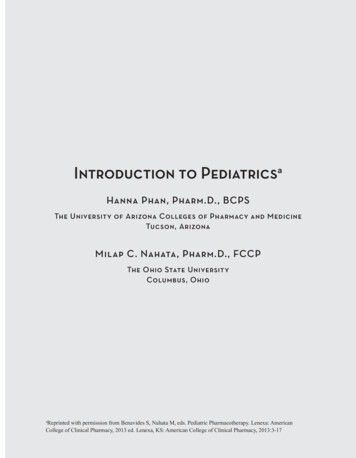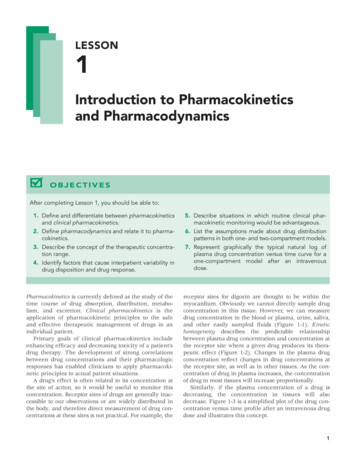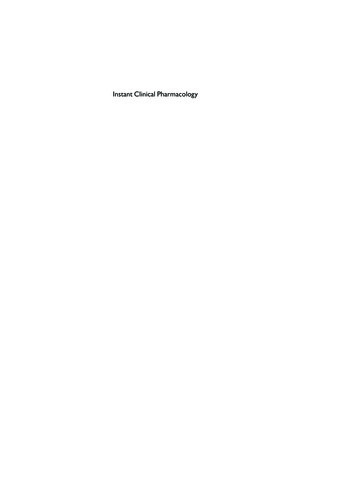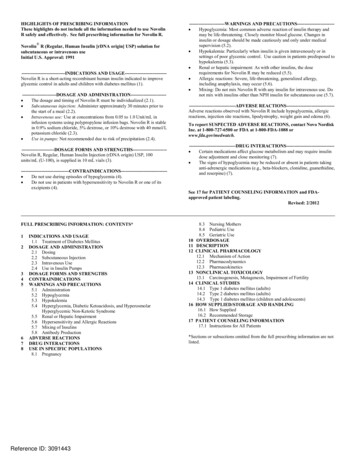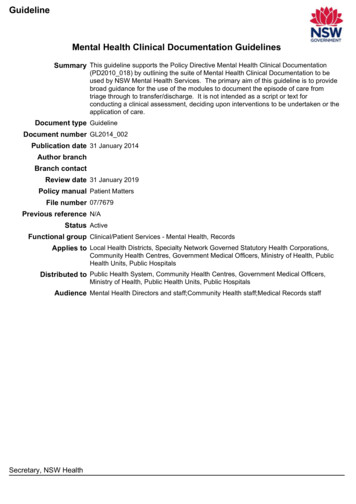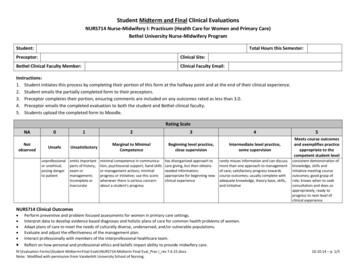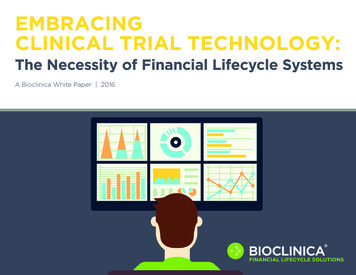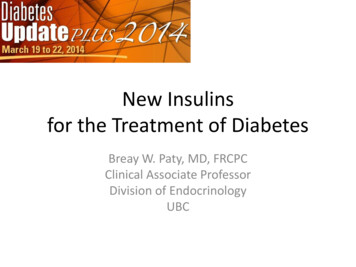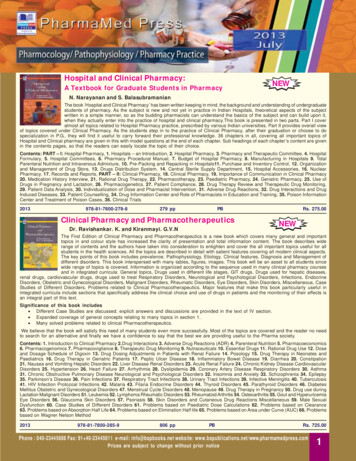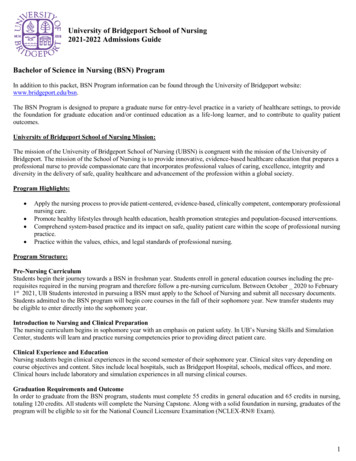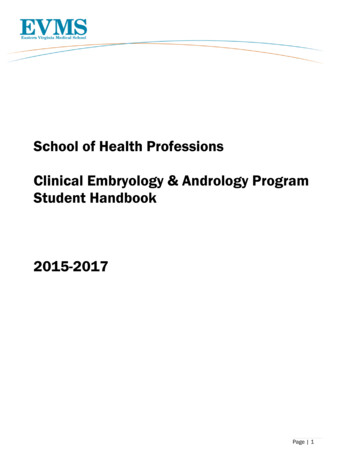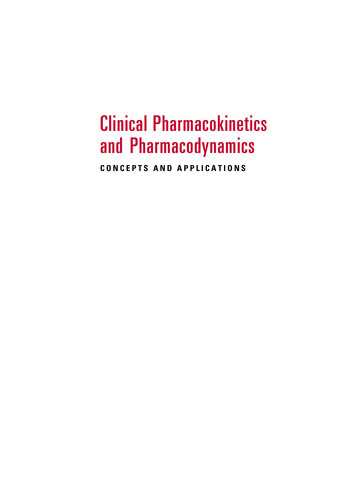
Transcription
18048 FM.qxd11/11/094:31 PMPage iClinical Pharmacokineticsand PharmacodynamicsCONCEPTS AND APPLICATIONS
18048 FM.qxd11/11/094:31 PMPage iiiFOURTH EDITIONClinical Pharmacokineticsand PharmacodynamicsConcepts and ApplicationsMalcolm Rowland, DSc, PhDThomas N. Tozer, PharmD, PhDProfessor EmeritusSchool of Pharmacy andPharmaceutical SciencesUniversity of ManchesterManchester, United KingdomProfessor EmeritusSchool of Pharmacy andPharmaceutical SciencesUniversity of California, San FranciscoAdjunct Professor of PharmacologySkaggs School of Pharmacy andPharmaceutical SciencesUniversity of California San DiegoWith Online Simulations byHartmut Derendorf, PhDDistinguished ProfessorGuenther Hochhaus, PhDAssociate ProfessorDepartment of PharmaceuticsUniversity of FloridaGainesville, Florida
18048 FM.qxd11/11/094:31 PMPage ivAcquisitions Editor: David B. TroyProduct Manager: Matt HauberMarketing Manager: Allison PowellDesigner: Doug SmockCompositor: Maryland Composition Inc./ASIFourth EditionCopyright 2011 Lippincott Williams & Wilkins, a Wolters Kluwer business351 West Camden Street530 Walnut StreetBaltimore, MD 21201Philadelphia, PA 19106Printed in ChinaAll rights reserved. This book is protected by copyright. No part of this book may be reproduced ortransmitted in any form or by any means, including as photocopies or scanned-in or other electroniccopies, or utilized by any information storage and retrieval system without written permission fromthe copyright owner, except for brief quotations embodied in critical articles and reviews. Materialsappearing in this book prepared by individuals as part of their official duties as U.S. government employees are not covered by the above-mentioned copyright. To request permission, please contactLippincott Williams & Wilkins at 530 Walnut Street, Philadelphia, PA 19106, via email at permissions@lww.com, or via website at lww.com (products and services).9 8 7 6 5 4 3 2 1Library of Congress Cataloging-in-Publication DataRowland, Malcolm.Clinical pharmacokinetics and pharmacodynamics : concepts and applications / MalcolmRowland and Thomas N. Tozer. —4th ed.p. ; cm.Rev. ed. of: Clinical pharmacokinetics. 1995.ISBN 978-0-7817-5009-71. Pharmacokinetics. 2. Chemotherapy. I. Tozer, Thomas N. II. Rowland, Malcolm. Clinical pharmacokinetics. III. Title.[DNLM: 1. Pharmacokinetics. 2. Drug Therapy. QV 38 R883c 2009]RM301.5.R68 2009615 .7—dc222009028928DISCLAIMERCare has been taken to confirm the accuracy of the information present and to describe generally accepted practices. However, the authors, editors, and publisher are not responsible for errorsor omissions or for any consequences from application of the information in this book and makeno warranty, expressed or implied, with respect to the currency, completeness, or accuracy of thecontents of the publication. Application of this information in a particular situation remains theprofessional responsibility of the practitioner; the clinical treatments described and recommendedmay not be considered absolute and universal recommendations.The authors, editors, and publisher have exerted every effort to ensure that drug selection anddosage set forth in this text are in accordance with the current recommendations and practice atthe time of publication. However, in view of ongoing research, changes in government regulations,and the constant flow of information relating to drug therapy and drug reactions, the reader isurged to check the package insert for each drug for any change in indications and dosage and foradded warnings and precautions. This is particularly important when the recommended agent is anew or infrequently employed drug.Some drugs and medical devices presented in this publication have Food and DrugAdministration (FDA) clearance for limited use in restricted research settings. It is the responsibility of the health care provider to ascertain the FDA status of each drug or device planned for usein their clinical practice.To purchase additional copies of this book, call our customer service department at (800) 638-3030or fax orders to (301) 223-2320. International customers should call (301) 223-2300.Visit Lippincott Williams & Wilkins on the Internet: http://www.lww.com. Lippincott Williams & Wilkinscustomer service representatives are available from 8:30 am to 6:00 pm, EST.
18048 FM.qxd11/11/094:31 PMPage vTo Dawn and Margaretfor their continual love, patience, and tolerance.
18048 FM.qxd11/11/094:31 PMPage viiABOUT THE AUTHORSMALCOLM ROWLANDMalcolm Rowland is Professor Emeritus and former Dean(1998–2001), School of Pharmacy and Pharmaceutical Sciences,University of Manchester, and Adjunct Professor, School ofPharmacy, University of California, San Francisco. He wasPresident of the European Federation of Pharmaceutical Sciences(1996–2000) and Vice-President, International PharmaceuticalFederation (FIP; 2001–2008), the organization that representsand serves pharmacy and pharmaceutical sciences around theglobe. He received his pharmacy degree and PhD from theUniversity of London, and was on faculty at the School of Pharmacy, University ofCalifornia, San Francisco (1967–1975).Dr. Rowland, together with Dr. Thomas Tozer, authored the introductory textbook,Introduction to Pharmacokinetics and Pharmacodynamics: The Quantitative Basis of DrugTherapy. He has authored over 300 scientific articles and chapters. His research interest isprimarily in physiologically-based pharmacokinetics and its application to drug development and clinical use. In particular, he has pioneered the concept and application ofclearance and developed approaches to the prediction of pharmacokinetics of drugsfrom a combination of physicochemical properties and in vitro information. He was aneditor of the Journal of Pharmacokinetics and Pharmacodynamics (1973–2006), the premier journal dedicated to the subject, and has established workshops for teaching bothbasic- and advanced-level pharmacokinetics. He is an advisor to the pharmaceuticalindustry and sits on various scientific advisory boards.Dr. Rowland has been awarded honorary doctorate degrees from the University ofPoitiers (France) and Uppsala University (Sweden) as well as Honorary Membership ofthe Royal College of Physicians (London). He received various awards including theDistinguished Investigator Award of the American College of Clinical Pharmacology(ACCP, 2007) and the Millennial Pharmaceutical Scientist Award (FIP BPS, 2000). Hehas been made a fellow of the Academy of Medical Sciences, ACCP (Hon), AmericanAssociation of Pharmaceutical Scientists, the Royal Pharmaceutical Society of GreatBritain, and the Institute of Mathematics.THOMAS N. TOZERDr. Tozer, Professor Emeritus of Biopharmaceutical Sciences andPharmaceutical Chemistry, School of Pharmacy, University ofCalifornia, San Francisco, received his BS, PharmD, and PhD degrees from the University of California, San Francisco. He is currently an Adjunct Professor of Pharmacology at the University ofCalifornia, San Diego, where he teaches biopharmaceutics andclinical pharmacokinetics at the Skaggs School of Pharmacy andPharmaceutical Sciences. After a 2-year postdoctoral fellowship inthe laboratory of Dr. B. B. Brodie, National Institutes of Health,vii
18048 FM.qxdviii11/11/094:31 PMPage viiiABOUT THE AUTHORSBethesda, Maryland, he joined the Faculty of the School of Pharmacy in San Francisco in1965. Although now in emeritus status, he continues to teach courses and workshops inpharmacokinetics/pharmacodynamics and clinical pharmacokinetics at several institutions in the United States and Europe.Dr. Tozer, together with Dr. Malcolm Rowland, authored Clinical Pharmacokinetics:Concepts and Applications, the title of the first three editions of this textbook. He has published more than 155 scientific papers on a variety of research topics with emphasis onthe development and application of kinetic concepts in drug therapy. Dr. Tozer’sresearch before retirement was focused in four areas: colon-specific drug delivery, toxicokinetics, kinetics of potential contrast agents for magnetic resonance imaging, and nonlinear pharmacokinetics. Other research included determination of drug disposition indisease states, particularly end-state renal disease. Emphasis here was placed on evaluating and predicting when and how drug administration to renal disease patients shouldbe altered.Dr. Tozer was a corecipient of the 2000 Meritorious Manuscript Award, AmericanAssociation of Pharmaceutical Scientists, and was a Visiting Professor (1996–1999) at theUniversity of Manchester, Manchester, England. He is a Fellow of the AmericanAssociation of Pharmaceutical Scientists and has served as a consultant to the Food andDrug Administration and to many pharmaceutical companies.
18048 FM.qxd11/11/094:31 PMPage ixPREFACEuch has happened in the field of our textbook since the last edition was publishedin 1995. First, in recognition that there was a readership that sought a less in-depthtextbook we wrote a companion, entitled Introduction to Pharmacokinetics andPharmacodynamics: The Quantitative Basis of Drug Therapy; it was published in 2006. While emphasizing pharmacokinetics, the widening to include pharmacodynamics as an integralpart of this introductory text reflected the increasing body of knowledge linking the two elements that explain the relationship between drug administration and response. We havecontinued this trend of integrating pharmacodynamics with pharmacokinetics in the current text, which is reflected in the title. Second, in addition to an expanding knowledge ofpharmacodynamics, there has been an explosion in our understanding at the molecularand mechanistic levels of all the processes controlling the pharmacokinetics of drugs. Theavailability of the introductory text has therefore allowed us the opportunity to expand inthis current edition on these new insights for those readers wishing to gain a greater indepth understanding of the subject. This has required some enlargement over previouseditions, but every attempt has been made to limit the size of the book.As in our previous three editions, we are committed to developing and applying theconcepts to explain and improve the therapeutic use of drugs. As such, we continue tohave students and practitioners in pharmacy, medicine, pharmacology, and allied professions in mind as our readers. Accordingly, although the principles have wide application,emphasis continues to be at the clinical level. We recognize, however, that pharmacokinetics and pharmacodynamics are cornerstones in the industrial design, selection, anddevelopment of new drugs, and so believe that this textbook is of equal value to scientistsengaged in all aspects of the pharmaceutical industry, as well as those working in regulatory agencies evaluating drug applications.In addition to more detailed consideration of the basic principles compared to the introductory text, the current textbook expands greatly on why individuals vary in their response to drugs, which is central to personalizing drug therapy. Furthermore, there is anincrease in the number of thought-provoking problems at the end of each chapter, withanswers provided in the last appendix. While maintaining the overall structure and organization, there are also significant improvements over the third edition. In particular,we have incorporated advances in our understanding of the role of enzymes and transporters in pharmacokinetics, and of genetics in both pharmacokinetics and pharmacodynamics. As briefly mentioned above, we have greatly expanded on pharmacodynamics,which was a single chapter in the specialized topic section of the last edition, and have integrated it throughout the book. We have also incorporated Turnover Concepts andDialysis, which were also previously specialized topics, into the body of the book, recognizing that these are fundamental to the subject. We have also added two new chapters.One deals with protein drugs, reflecting the rapid increase in recent years in the numberof such medicines that have become a part of the armamentarium of modern therapeutics. The second concerns the prediction of human pharmacokinetics from in vitro andpreclinical data, and subsequent simulation of likely kinetics in patients under a wide variety of clinical conditions and situations, which can improve the chances of selectingcompounds that have desirable pharmacokinetic characteristics in planning clinical drugtrials and in ensuring their subsequent optimal use.Mix
18048 FM.qxdx11/11/094:31 PMPage xPREFACEWe have also updated all chapters and replaced many of the examples and case histories with more modern ones, while providing many new problems with answers. To helpapproach these problems, we have provided at the end of each chapter a summary of keyrelationships. In addition, Drs. Hartmut Derendorf and Guenther Hochhaus, Universityof Florida, have prepared web-based simulations of many of the concepts presentedthroughout the book. The simulations allow the reader to explore the influence ofchanges in parameter values in both pharmacokinetics and pharmacodynamics on drugconcentration and response with time following drug administration. Finally, to conformto the quality of all new figures, of which there are many, we have redrawn or improvedthe figures retained from previous editions.ACKNOWLEDGMENTSAs with all previous editions, we wish to thank the many students, as well as participants ofvarious workshops that we have taught, and colleagues for helping us shape the fourthedition. Their enthusiasm, commitment, and appreciation continue to be a source ofimmense satisfaction to us. We would also like to thank in particular Joe Balthasar for critiquing the protein drug chapter and Amin Rostami for assistance in the simulation ofpharmacokinetic profiles in virtual patient populations.It is now 30 years since the first edition of our textbook was published. Throughoutthis period, we have been enormously gratified by the wide and varied readership aroundthe world, sometimes in the most unexpected of places. Our wish has always been to contribute to the improved design and more rational use of medicines. We hope that thisfourth edition helps further this aspiration.Malcolm Rowland, Manchester, UKThomas N. Tozer, San Francisco, California
18048 FM.qxd11/11/094:31 PMPage xiTABLE OF CONTENTSPreface ixNonproprietary and Brand Names of Drugs in Text and IllustrationsDefinition of Symbols xixxiiiSECTION I BASIC CONSIDERATIONS1 Therapeutic Relevance . . . . . . . . . . . . . . . . . . . . . . . . . . . . . . . . . . . . . . . . . . 32 Fundamental Concepts and Terminology . . . . . . . . . . . . . . . . . . . . . . . . . 17SECTION II345678EXPOSURE AND RESPONSE AFTER A SINGLE DOSEKinetics Following an Intravenous Bolus Dose . . . . . . . . . . . . . . . . . . . . . . 49Membranes and Distribution . . . . . . . . . . . . . . . . . . . . . . . . . . . . . . . . . . . . 73Elimination . . . . . . . . . . . . . . . . . . . . . . . . . . . . . . . . . . . . . . . . . . . . . . . . . 111Kinetics Following an Extravascular Dose . . . . . . . . . . . . . . . . . . . . . . . . . 159Absorption . . . . . . . . . . . . . . . . . . . . . . . . . . . . . . . . . . . . . . . . . . . . . . . . . . 183Response Following a Single Dose . . . . . . . . . . . . . . . . . . . . . . . . . . . . . . . 217SECTION IIITHERAPEUTIC REGIMENS9 Therapeutic Window . . . . . . . . . . . . . . . . . . . . . . . . . . . . . . . . . . . . . . . . . .24510 Constant-Rate Input . . . . . . . . . . . . . . . . . . . . . . . . . . . . . . . . . . . . . . . . . . 25911 Multiple-Dose Regimens . . . . . . . . . . . . . . . . . . . . . . . . . . . . . . . . . . . . . . 293SECTION IV12131415161718INDIVIDUALIZATIONVariability . . . . . . . . . . . . . . . . . . . . . . . . . . . . . . . . . . . . . . . . . . . . . . . . . . 333Genetics . . . . . . . . . . . . . . . . . . . . . . . . . . . . . . . . . . . . . . . . . . . . . . . . . . . . 357Age, Weight, and Gender . . . . . . . . . . . . . . . . . . . . . . . . . . . . . . . . . . . . . . 373Disease . . . . . . . . . . . . . . . . . . . . . . . . . . . . . . . . . . . . . . . . . . . . . . . . . . . . . 403Nonlinearities . . . . . . . . . . . . . . . . . . . . . . . . . . . . . . . . . . . . . . . . . . . . . . . 445Drug Interactions . . . . . . . . . . . . . . . . . . . . . . . . . . . . . . . . . . . . . . . . . . . . 483Initiating and Managing Therapy . . . . . . . . . . . . . . . . . . . . . . . . . . . . . . . 527xi
18048 FM.qxd11/11/09xii4:31 PMPage xiiTABLE OF CONTENTSSECTION V SUPPLEMENTAL TOPICS19202122Distribution Kinetics . . . . . . . . . . . . . . . . . . . . . . . . . . . . . . . . . . . . . . . . . . 561Metabolites and Drug Response . . . . . . . . . . . . . . . . . . . . . . . . . . . . . . . . 603Protein Drugs . . . . . . . . . . . . . . . . . . . . . . . . . . . . . . . . . . . . . . . . . . . . . . . 633Prediction and Refinement of Human Kinetics from In Vitro,Preclinical, and Early Clinical Data . . . . . . . . . . . . . . . . . . . . . . . . . . . . . . 663APPENDICESA.B.C.D.E.F.G.H.I.J.IndexAssessment of AUC . . . . . . . . . . . . . . . . . . . . . . . . . . . . . . . . . . . . . . . . . . . .687Ionization and the pH Partition Hypothesis . . . . . . . . . . . . . . . . . . . . . . .691Distribution of Drugs Extensively Bound to Plasma Proteins . . . . . . . . . .695Plasma-to-Blood Concentration Ratio . . . . . . . . . . . . . . . . . . . . . . . . . . . .703Well-stirred Model of Hepatic Clearance . . . . . . . . . . . . . . . . . . . . . . . . . .705Absorption Kinetics . . . . . . . . . . . . . . . . . . . . . . . . . . . . . . . . . . . . . . . . . . .709Wagner-Nelson Method . . . . . . . . . . . . . . . . . . . . . . . . . . . . . . . . . . . . . . .713Mean Residence Time . . . . . . . . . . . . . . . . . . . . . . . . . . . . . . . . . . . . . . . . .717Amount of Drug in Body on Accumulation to Plateau . . . . . . . . . . . . . . .723Answers to Study Problems . . . . . . . . . . . . . . . . . . . . . . . . . . . . . . . . . . . . .727819
18048 FM.qxd11/11/094:31 PMPage xiiiNONPROPRIETARY AND BRAND NAMESOF DRUGS IN TEXT AND ILLUSTRATIONS(For those drugs available only by brand name at time of manuscript submission, thebrand name is cetaminophenAcetazolamideAcetylsalicylic ate sodiumAlfentanilAlglucosidase inAmilorideAminosalicylic ihemophilicFactor (VIII)Antithrombin IIIAprepitantAprotininAscorbic pules andEntocort salmonCapromab eCefotaximeMiacalcinProstaScint Kitxiii
18048 FM.qxdxiv11/11/094:31 PMPage xivNONPROPRIETARY AND BRAND NAMES OF DRUGS IN TEXT AND arithromycinClavulanateClobazamClofibric acidClonazepamClonidineClopidogrelClotting Factor VIIaClotting Factor tisolCosyntropinCrotalidae DebrisoquineDelavirdine mesylateDenileukin eDesmopressin bamazepineDiflunisalDigitoxinDigoxinDigoxin immune eDobutamineDolasetron mesylateDonepezilDornase yllotoxinEpoetin aptivaFuzeonEpogenIntegrilin
18048 FM.qxd11/11/094:31 PMPage xvNONPROPRIETARY AND BRAND NAMES OF DRUGS IN TEXT AND nyl nreleasing hormoneGoserelinGriseofulvinGrowth with ethinylestradiol)Zetia (alsocombinedwithsimvastatin[Vytorin arMylotargZoladexxvHalothaneHeparinHepatitis B immune enemImipramineImirestatIndinavirIndocyanine greenIndomethacinInfliximabInsulinInsulin glargineInterferonalfacon-1Interferon Alpha-2b(pegylated)Interferon Beta-1aInterleukin-11(Oprelvekin)Intravenous idIsosorbide lide, rudinLeucovorinLeuprolide AravaRefludan
18048 FM.qxdxvi11/11/094:31 PMPage xviNONPROPRIETARY AND BRAND NAMES OF DRUGS IN TEXT AND i-thymocyteimmune ateMethylprednisoloneMetoprolol r gestrominKaletra(combinedwith ritonavir)HyzaarArimaMenopurSingulairViraceptOrtho Evra(combinedwith ethinylestradiol)NorepinephrineNorfloxacinNormal xetinePegvisomantPenciclovirPenicillin nePertussis enicalSynagisArediaVectibixDenavirTalwin (combinedwithnaloxone)
18048 FM.qxd11/11/094:31 PMPage xviiNONPROPRIETARY AND BRAND NAMES OF DRUGS IN TEXT AND ILLUSTRATIONSPiroxicamPivampicillinPolymyxinB inePyridostigmineSirolimusSomatropinSparteineSt. John’s SumatriptanQuinacrineQuinidine sulfateRabies fentanilRho(D) neRolipramRosiglitazoneRosuvastatinSalicylic acidSaquinavir vofluraneSildenafil eTeriparatideTestosteroneTetanus roxineTiclopidineTimolol tivator (t-PA)TobramycinTolbutamideTolmetinTolterodine BexxarMavikHerceptinSurmontilxvii
18048 FM.qxd11/11/09xviii4:31 PMPage xviiiNONPROPRIETARY AND BRAND NAMES OF DRUGS IN TEXT AND ILLUSTRATIONSVaccinia immuneglobulinValganciclovirValproic acidValsartanVancomycinVaricella-zosterimmune deDiovanVinblastineVincristineViomycinVitamin astZidovudineZileutonZoledronic acidAccolateZyfloReclast, Zometa
18048 FM.qxd11/11/094:31 PMPage xixDEFINITIONS OF SYMBOLS(Typical units are shown)AAmount of drug in body, mg or mol.AaAmount of drug at absorption site remaining to be absorbed, mgor mol.Aav,ssAverage amount of drug in body during a dosing interval at steadystate, mg or mol.AeCumulative amount of drug excreted in the urine, mg or mol.Ae Cumulative amount of drug excreted in the urine after a singledose to time infinity, mg or mol.AinfAmount of drug in body during a constant-rate infusion, mg or mol.A(m)Amount of metabolite in the body, mg or mol.AminThe minimum amount of drug in body required to obtain apredetermined level of response, mg or mol.Amax,N; Amin,NMaximum and minimum amounts of drug in body after the Nthdose of fixed size and given at a fixed dosing interval, mg or mol.AN,tAmount of drug in body at time t after the Nth dose, mg or mol.AssAmount of drug in body at steady state during constant-rateadministration, mg or mol.Amax,ss; Amin,ssMaximum and minimum amounts of drug in body during a dosinginterval at steady state on administering a fixed dose at a fixeddosing interval, mg or mol.AUCArea under the plasma drug concentration-time curve. Total areafrom time 0 to infinity is implied unless the local context indicatesa specific time interval (e.g., a dosing interval), mg-hr/L or M-hr.AUCbArea under the blood concentration-time curve, mg-hr/L or M-hr.AUC(m)Area under the plasma metabolite concentration-time curve,mg-hr/L or M-hr.AUCssArea under the plasma concentration-time curve within a dosinginterval at steady state, mg-hr/L or M-hr.AUMCTotal area under the first moment-time curve, mg-hr2/L or M-hr2.BMIBody mass index, kg/m2.BSABody surface area, m2.CConcentration of drug in plasma (or reservoir), mg/L or M.C50Concentration giving one-half the maximum effect, mg/L or M.C(0)Initial plasma concentration obtained by extrapolation to timezero, after an intravenous bolus dose, mg/L or M.CADrug concentration in arterial blood, mg/L or M.xix
18048 FM.qxd11/11/09xx4:31 PMPage xxDEFINITIONS OF SYMBOLSEHEmaxAverage drug concentration in plasma during a dosing interval atsteady state on administering a fixed dose at equal dosing intervals,mg/L or M.Concentration of drug in plasma during a constant-rate infusion,mg/L or mM.Concentration of drug in blood, mg/L or M.Total clearance of drug from plasma, L/hr or mL/min.Total clearance of drug from blood, L/hr or mL/min.Hepatic clearance of drug from blood, L/hr or mL/min.Renal clearance of creatinine, mL/min or L/hr.Clearance by dialysis procedure, L/hr or mL/min.Hepatic clearance of drug from plasma, L/hr or mL/min.Intrinsic clearance of drug in organ of elimination (well-stirredmodel), L/hr or mL/min.Renal clearance of drug from plasma, L/hr or mL/min.Clearance of unbound drug, L/hr or mL/min.Lower and upper bounds of the therapeutic window of plasmaconcentrations, mg/L or M.Highest drug concentration observed in plasma afteradministration of an extravascular dose, mg/L or M.Maximum and minimum concentrations of drug in plasma atsteady state on administering a fixed dose at equal dosing intervals,mg/L or M.Concentration of a metabolite in plasma, mg/L or M.Concentration of a metabolite in plasma at steady state during aconstant-rate infusion of a drug, mg/L or M.Concentration of drug in plasma required to give the minimumeffect, mg/L or M.Concentration leaving the extractor in the reservoir model, mg/Lor M.Concentration of drug in plasma at steady state during constantrate administration, mg/L or M.Average concentration of drug in tissues outside plasma, mg/L or M.Unbound drug concentration in plasma, mg/L or M.Unbound drug concentration within hepatocytes, mg/L or M.Concentration of drug in venous blood, mg/L or M.Loading (or priming) dose, mg.Maintenance dose given every dosing interval, mgLargest maintenance dose that will keep systemic exposure withinthe therapeutic window, mg.Extraction ratio, no units.In pharmacodynamics, E means “effect,” which may be either clinically desirable or adverse. Units are those of response measured.Hepatic extraction ratio, no units.Maximum effect, units of response measurement.ERRenal extraction ratio, no lower, CupperCmaxCmax,ss, Cmin,ssC(m)C(m)ssCminCoutCssCTCuCuHCVDLDMDM,maxE
18048 FM.qxd11/11/094:31 PMPage xxiDEFINITIONS OF SYMBOLSFfDfeFevFEV1FFFGFHfmFmFRfufubfuPfuRfuT GFRkkaKaKdKIKmKpKp,bKTktkT 1, 2mMRTnNxxiBioavailability of drug, no units.Fraction of total elimination occuring by dialysis, no units.Frac
rently an Adjunct Professor of Pharmacology at the University of California, San Diego, where he teaches biopharmaceutics and clinical pharmacokinetics at the Skaggs School of Pharmacy and Pharmaceutical Sciences. After a 2-year postdoctoral fellowship in the laboratory of Dr. B. B. Bro
